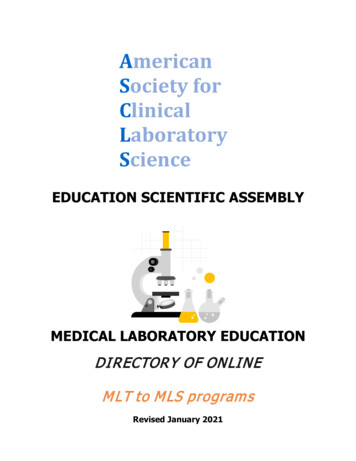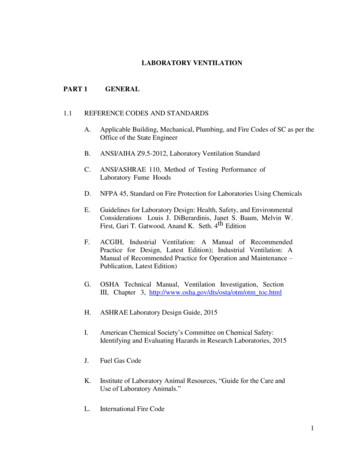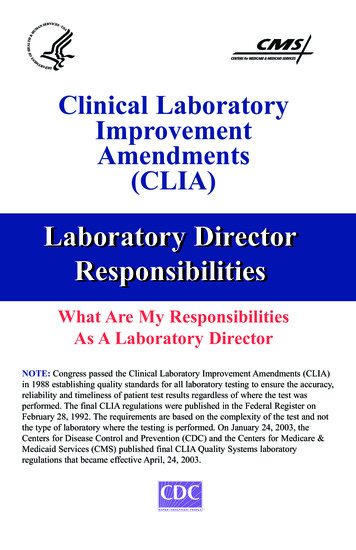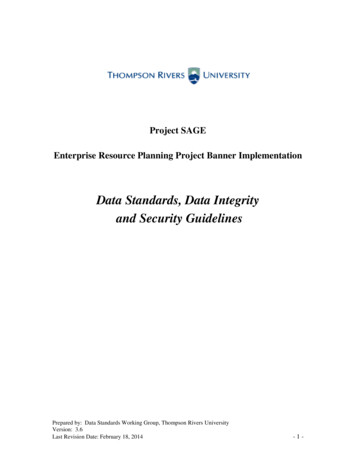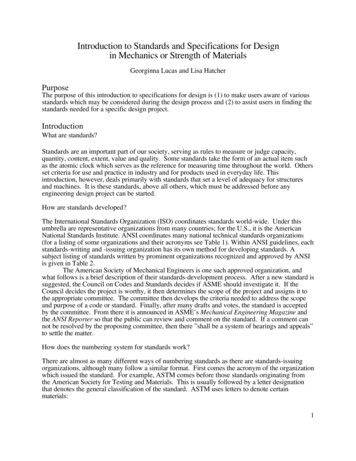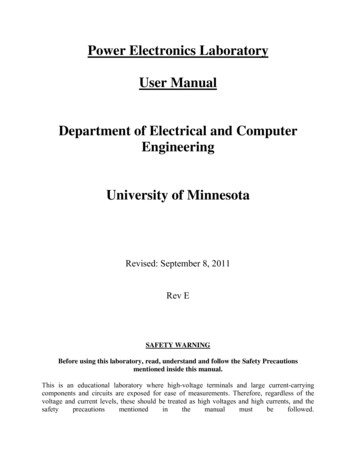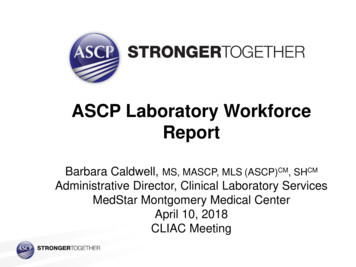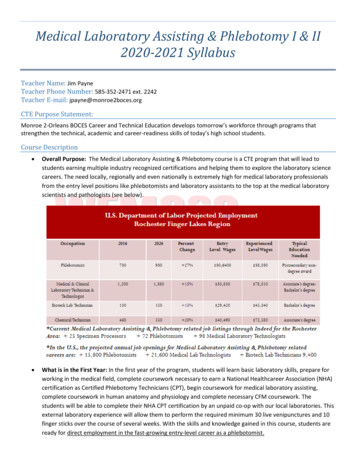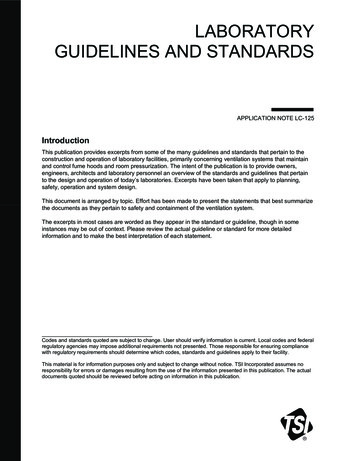
Transcription
LABORATORYGUIDELINES AND STANDARDSAPPLICATION NOTE LC-125IntroductionThis publication provides excerpts from some of the many guidelines and standards that pertain to theconstruction and operation of laboratory facilities, primarily concerning ventilation systems that maintainand control fume hoods and room pressurization. The intent of the publication is to provide owners,engineers, architects and laboratory personnel an overview of the standards and guidelines that pertainto the design and operation of today’s laboratories. Excerpts have been taken that apply to planning,safety, operation and system design.This document is arranged by topic. Effort has been made to present the statements that best summarizethe documents as they pertain to safety and containment of the ventilation system.The excerpts in most cases are worded as they appear in the standard or guideline, though in someinstances may be out of context. Please review the actual guideline or standard for more detailedinformation and to make the best interpretation of each statement.Codes and standards quoted are subject to change. User should verify information is current. Local codes and federalregulatory agencies may impose additional requirements not presented. Those responsible for ensuring compliancewith regulatory requirements should determine which codes, standards and guidelines apply to their facility.This material is for information purposes only and subject to change without notice. TSI Incorporated assumes noresponsibility for errors or damages resulting from the use of the information presented in this publication. The actualdocuments quoted should be reviewed before acting on information in this publication.
Table of ContentsIntroduction . 1Laboratory Chemical Hoods . 3Usage . 3Sash-Closers . 4Location . 4Face Velocity . 5Face Velocity Monitors. 7Sash Alarms . 8Flow Visualization Testing . 8Face Velocity Testing . 9Competing Air Flow Testing . 10VAV Response Time Testing . 10Containment Testing . 11Frequency Of Testing. 12Minimum Exhaust (VAV). 14Emergency Modes . 14Fire Suppression . 15Perchloric Acid Hoods . 16Radioisotope Hoods . 18Ductless Hoods . 19Chemical Laboratories . 21Ventilation Rates . 21Fume Hood Diversity . 22Recirculation . 23Emergency Modes . 24Room Pressure Differential . 25Use Of Airlocks . 29Room Pressure Alarms . 29Directional Air Flow. 29Exhaust Ductwork Design . 29Exhaust Ductwork Construction . 30Duct Velocities. 32Manifolded Exhaust . 32Exhaust Fan Operation . 33Commissioning Instrumentation . 35References . 36–2–
Laboratory Chemical HoodsTopicStandardUsageANSI/AIHA Z9.5-2003American National Standards for Laboratory Ventilation2.1.1Laboratory Chemical HoodsAdequate laboratory chemical hoods, special purpose hoods, or otherengineering controls shall be used when there is a possibility of employeeoverexposure to air contaminants generated by a laboratory activity US OSHA, 29 CFR Part 1910.1450 Occupational Exposure to HazardousChemicals in LaboratoriesAppendix A - National Research Council Recommendations ConcerningChemical Hygiene in LaboratoriesA. General Principles for Work with Laboratory Chemicals3. Provide adequate ventilation. The best way to prevent exposure toairborne substances is to prevent their escape into the workingatmosphere by use of hoods and other ventilation devices (32, 198).C. The Laboratory Facility4. Ventilation(b) Hoods.A laboratory hood with 2.5 linear feet of hood space per personshould be provided for every 2 workers if they spend most of theirtime working with chemicals; If this is not possible, work withsubstances of unknown toxicity should be avoided or other types oflocal ventilation devices should be provided.E. Basic Rules and Procedures for Working with Chemicals1. General Rules(n) Use of hood:Use the hood for operations which might result in release of toxicchemical vapors or dust. As a rule of thumb, use a hood or otherlocal ventilation device when working with any appreciably volatilesubstance with a TLV of less than 50 ppm Leave the hood “on” when it is not in active use if toxic substancesare stored in it or if it is uncertain whether adequate generallaboratory ventilation will be maintained when it is ‘off’.National Fire Protection Association, Standard NFPA 45-20006.4Exhaust Air Discharge6.4.8Canopy hoods shall not be used in lieu of laboratory hoods.6.4.9Biological safety cabinets shall not be used in lieu of laboratoryhoods.6.4.10Laminar flow cabinets shall not be used in lieu of laboratory hoods.–3–
TopicStandardSash-ClosersANSI/AIHA Z9.5-2003American National Standards for Laboratory Ventilation3.1.1.4 Automatic Sash ClosersThe following factors shall be considered before automatic sash closingdevices are installed on a laboratory chemical hood: The adverse effect on energy consumption when the operators feel it istheir responsibility to close the sash; and The adverse effect on energy consumption when the operators do notfeel it is their responsibility to close the sash.The following conditions shall be met before using automatic sash closingdevices: All users must be aware of any limitations imposed on their ability to usethe hood. Automatic sash positioning systems shall have obstruction sensingcapable of stopping travel during sash closing operations withoutbreaking glassware, etc. Automatic sash positioning shall allow manual override of positioningwith forces of no more than 10 lbs (45 N) mechanical both whenpowered and during fault modes during power failures.LocationScientific Equipment Furniture Association, Standard SEFA 1.2-20025.1Location in LaboratoryLaboratory fume hood exhaust systems should be balanced with roomexhaust systems and may be used in conjunction with room exhaust toprovide the necessary room ventilation. Constant operation of a fume hoodwill also provide fume control during non-working hours ANSI/AIHA Z9.5-2003American National Standards for Laboratory Ventilation3.3.4Hood LocationLaboratory chemical hoods shall be located so their performance is notadversely affected by cross drafts. Windows in laboratories with hoods shallbe fully closed while hoods are in use (emergency conditions excepted).National Fire Protection Association, Standard NFPA 45-20006.9Laboratory Hood Location6.9.1Laboratory hoods shall be located in areas of minimum airturbulence.6.9.2For new installations, laboratory hoods shall not be locatedadjacent to a single means of access to an exit or to high-traffic areas.6.9.3Workstations where personnel will spend much of their workingday, such as desks or microscope benches, shall not be located directly infront of laboratory hood openings.National Fire Protection Association, Standard NFPA 45-2000A6.9.1 A person walking past the hood can create sufficient turbulence todisrupt a face velocity of 0.5 m/sec (100 ft/min). In addition, open windows orair impingement from an air diffuser can completely negate or dramaticallyreduce the face velocity and can also affect negative differential airpressure.–4–
TopicStandardLocation (cont.)Scientific Equipment Furniture Association, Standard SEFA 1.2-20025.1Location in LaboratoryLaboratory fume hoods should be so located within the laboratory to avoidcrosscurrents at the fume hood face due to heating, cooling or ventilationinlets.Sufficient makeup air must be available within the laboratory to permit fumehoods to operate at their specified face velocities.Other location factors to be considered are as follows: Number and types of fume hood in laboratory space; Location and number of ingress/egress aisles and/or laboratory spaceexterior doorways; Frequency and/or volume of expected fume hood users; Location of laboratory safety equipment5.2Safety ConsiderationsLaboratory fume hoods are potential locations for fires and explosions due tothe types of experiments conducted in these units. As such, fume hoodsshould be located within the laboratory so that in the event of a fire orexplosion within the fume hood, exit from the laboratory would not beimpeded.Laboratory fume hoods should be located away from high traffic lanes withinthe laboratory because personnel walking past the sash opening maydisrupt the flow of air into the unit and cause turbulence, drawing hazardousfumes into the laboratory.Sufficient aisle space should be provided in front of the fume hood to avoiddisruption of the work or interference with the operating technician bypassing personnel.ASHRAE, 1995 HVAC Applications HandbookChapter 13 Laboratory SystemsLaboratory Exhaust and Containment DevicesFume Hood PerformanceAir currents external to the fume hood can jeopardize fume hood’seffectiveness . Detrimental air currents can be produced by the following: Air supply distribution patterns Movement of the researcher People walking past the fume hood Thermal convection Opening of doors and windowsFace VelocityANSI/AIHA Z9.5-2003American National Standards for Laboratory Ventilation3.3.1Face VelocityThe average face velocity of the hood shall produce sufficient capture andcontainment of hazardous chemicals generated under as-used conditions.An adequate face velocity is necessary but is not the only criterion toachieve acceptable performance and shall not be used as the onlyperformance indicator.–5–
TopicStandardFace Velocity (cont.)3.3.1 (notes): Face VelocityDesign face velocities for laboratory chemical hoods in the range of 80 100fpm (0.41 0.51m/s) will provide adequate face velocity for a majority ofchemical hoods.Hoods with excellent containment characteris
Face Velocity ANSI/AIHA Z9.5-2003 American National Standards for Laboratory Ventilation 3.3.1 Face Velocity The average face velocity of the hood shall produce sufficient capture and containment of hazardous chemicals generated under as-used conditions. An adequate face velocity is necessary but is not the only criterion to



